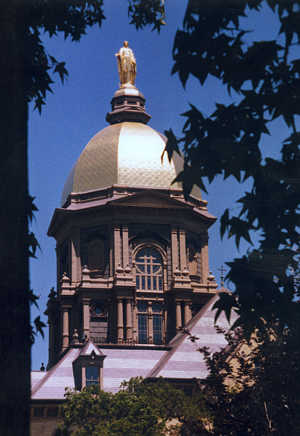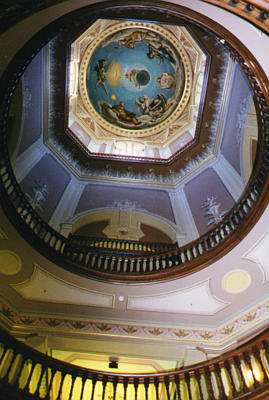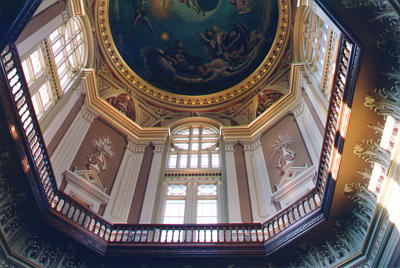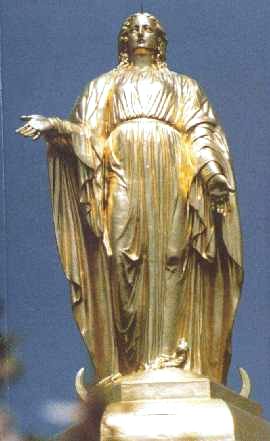
Notre Dame's Grotto / by Dorothy V. Corson

The Gilding of the Dome and Statue
 The Dome and statue were accomplished in 1883. A year later the crown and crescent were added. Three years later, in 1886, the Dome and Statue were gilded for the first time.
The Dome and statue were accomplished in 1883. A year later the crown and crescent were added. Three years later, in 1886, the Dome and Statue were gilded for the first time.
Father John W. Cavanaugh's unpublished manuscript described the reception Sorin received when he announced the gilding of the Dome and the Statue:
Later, in 1886, Father Sorin decided that at last his old dream might be completely realized by the gilding of the Dome. A gift of two thousand dollars made this possible and the happiness of the founder was complete.
I remember hearing him make the announcement at commencement from the stage of Washington Hall. There were many, of course, who turned up their noses at this also. It was another extravagant bit of pious sentimentality on the part of the old man, they said. The truth is it was cheaper than paint . . . and lasts longer. To put up the scaffolding alone for one painting of the dome would cost five hundred dollars. Paint would have to be renewed every few years. As a matter of fact, the gold leaf on the dome lasts from fifteen to twenty years and it is considerably cheaper than paint would be. Thus, once more, was the dream of the aged peer justified by the rude figures of commerce.(87)
Professor James Edwards, who was on campus at the time, placed several annotations correcting and amending the pages of Timothy Howard's, A Brief History of Notre Dame du Lac, an early history of the campus. A note in the front of the book, signed by him, confirmed these knowledgeable additions. One penciled note opposite Howard's description of the Dome provided a piece of information not commonly known:
The dome, as is well known, is surmounted by a colossal statue of the Blessed Virgin illuminated by an electric crown and crescent. The gold for the gilding of the dome was contributed by a devout client of Our Lady.(88)
The name Professor Edwards penciled in the margin stated Mary Phalen, Mother Angela's mother, was the devout client. It was one of Mrs. Phalen's last gifts, one among many. Mother Angela Gillespie died March 4, 1887, two years after her own Church of Loretto on the campus of St. Mary's was finally realized. Her mother followed her in death six months later on December 10, 1887. Mrs. Phelan also financed Washington Hall which is still used as a music and entertainment center.
There's an interesting parallel to Fr. Sorin's dream of having a golden lady, on a golden dome, dedicated to Our Lady. An excerpt from the October 1884 issue of the Scholastic refers to the Statue of Liberty, then nearing its completion, destined to be placed in the New York Harbor two years later:
It may perhaps seem strange to some that we should make any attempt at enthusiasm about the erection of a simple statue. But let us consider for a moment what an enthusiasm is there not spreading throughout the United States . . . in regard to the placing of the statue of "Liberty enlightening the world" -- in the New York Harbor. We grant there is a reason for it and a good one. It is because . . . the prevailing idea among the masses of our countrymen is that they realize the benefit of a free government and are willing to do anything that may give fitting expression to their sentiments. Should it then seem strange, that we here at Notre Dame, imbued . . . with Christian sentiments, and recognizing unmistakable evidences of the intervention and protection of the Mother of the world's Redeemer -- should be just as enthusiastic about any outward expression of homage and gratitude towards her?(89)
The Statue of Liberty -- proposed as a gift to the United States by France to commemorate its Independence -- had been the dream of its designer, Frederic Auguste Bartholdi, since 1871. It was a topic of worldwide interest until it was completed eleven years later, on May 21, 1884. It was shipped to the United States in 1885 where it awaited its dedication upon the completion of its pedestal.(90) Bartholdi's efforts to create the Statue of Liberty paralleled Sorin's struggles. Sorin's own words after the sad destruction of the Main Building by fire in 1879 express that same kind of indomitable spirit that never gives up:
The fire was my fault, he concluded. I came here as a young man and founded a university which I named after the Mother of God. Now she had to burn it to the ground to show me I dreamed too small a dream. Tomorrow we will build it bigger and, when it is built, we will put a gold dome on top with a golden statue of the Mother of God so that everyone who comes this way will know to whom we owe whatever great future this place has.(91)
Perhaps Father Sorin's even bigger dream might have been spurred on by the colossal vision of another Frenchman, Frederic Auguste Bartholdi, who also wouldn't give up on his dream. It was typical of Sorin that his Lady was placed on the Dome and dedicated in September of 1883, three years earlier than Barthodi's "Lady Liberty." Its final gilding occurred on September 22, 1886, a month before the Statue of Liberty was dedicated on October 28, 1886.
 In 1884 Father Sorin envisioned the completion of his dream which was finally accomplished in 1886, he died seven years later:
In 1884 Father Sorin envisioned the completion of his dream which was finally accomplished in 1886, he died seven years later:
The exterior of the beautiful Dome of Notre Dame is now finished, thank God! and not a dollar expended on it will ever be regretted. It is the grand feature of the place -- one of the chief ornaments of the West. But, beautiful as it looks, it is scarcely anything compared to what it will soon be, when covered, as originally intended, with the heavy and imperishable gilding of the purest gold which will reflect magically through the day the rays of the sun, and at night turn darkness into bright light, from the electric crown of twelve stars with which the whole figure of the Blessed Virgin is to be clothed, typifying the prophecy: And there appeared a great wonder in heaven: a woman clothed with the sun, and the moon under her feet, and on her head a crown of twelve stars (Apoc., xii, i). What a beautiful sight! -- one that has never been seen in this country.(92)
-- Sorin
The Scholastic reported another approval: "Signor Gregori who is quite familiar with the best domes in the world is delighted with the new Dome of Notre Dame."(93) Signor Gregori was the artist who painted the interior of Sacred Heart Church. He also painted the inner Dome and the murals on the main floor of the Administration Building.

Once again, history had proven what a visionary Sorin turned out to be. As early as 1844, Sorin had envisioned his Lady on the Dome when he wrote:
When this school, Our Lady's school, grows a bit more, I shall raise her aloft so that, without asking, all men shall know why we have succeeded here. To that lovely Lady, raised high on a dome, a Golden Dome, men may look and find the answer.(94)
In the 1993 Dome (95) the first close-up color photograph of the statue on the Dome was published in the yearbook. The delicately modeled face, the exquisite drapery of Our Lady's gown, the crescent moon and the serpent visible at her feet were captured on film by Bill Mowle. Such detail could only have been guessed at before from a distance. It is a beautiful statue and a most unusual photograph.
Another brief poem in the Scholastic celebrates her glowing image:

| Silent she stands, Our Lady of the Light Whose mercy keeps a watch upon the waters; Over our hearts, by day or dreamy night, May she hold sway, Fairest of Daughters.(96) |